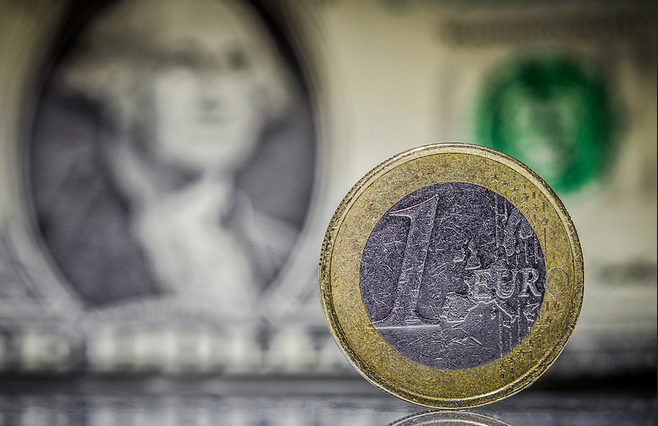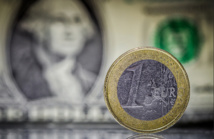The rate of fall of the euro against the dollar surpassed all expectations: in 2015 the single currency began at $ 1.21, a year ago costing about $ 1.40. Over the past 12 months, euro fell against the dollar by almost 23% and is now worth $ 1.06.
In summer of 2014 we talked about the fact that euro can reach parity with dollar, or even fall below it by the beginning of 2016. As a result, euro weakened faster than we expected - says Citi analyst Tom Fitzpatrick. Morgan Stanley’s Global Head of Foreign Exchange Strategy Hans Redeker, Deutsche Bank’s analysts Robin Winkler and George Saravelos, as well as Head of G-10 foreign-exchange strategy at Bank of America Merrill Lynch Athanasios Vamvakidis agree with him as well as with the fact that in the near future, euro will reach parity against dollar and will continue to weaken further.
Dates, when the parity can be achieved, may be different. Probably in the summer of 2015, - predicts Fitzpatrick. According to Morgan Stanley’s forecasts, in the fourth quarter of 2015, the rate will be $1.05 and will reach parity to the end of 2016 only. Winkler and Saravelos say that by the end of this year, euro will reach parity with the dollar; in 2016 will cost 90 cents, and by 2017 will get cheaper down to 85 cents.
Why falls
Fitzpatrick justifies his forecast in details. According to him, the dynamics of fundamentals in Europe is much worse than in 1998-1999, when there was parity too, but the US indices were similar.
Let us compare the two cycles. From the peak in May 2014 euro fell sharply against the dollar in the same way as after the peak in October 1998. The rate of fall in late 2014 - early 2015 was higher than in the previous cycle - says Fitzpatrick. - While the US data (GDP growth, unemployment, inflation) were similar in 2014 and 1998, European data is now much worse than they were in 1998.
First of all, the expectation of a stronger deceleration of inflation, leading to ECB’s actions more radical than expected led to sharp weakening of euro, - says about the reasons for the euro’s fall Hans Redeker.
Robin Winkler and George Saravelos at Deutsche Bank think a large-scale capital flight from Europe is the main reason for the fall of the euro. Most of the funds are spent in the US, UK and Canada.
This is understandable: ECB is just starting a program of quantitative easing, meanwhile US Federal Reserve System tightens monetary policy since the end of June last year. The program of quantitative easing by ECB, which was announced in January and launched a few days ago, will increase the monetary base in the euro zone's for € 1 trillion, or 10% of eurozone GDP. Monetary expansion has led to the fact that the European sovereign bonds traded at a record low plank, and many of them - with negative returns.
In these circumstances, dollar assets look more attractive: while, for example, two-year papers in Germany and France promised to yield less than 0% (that is traded at a premium), similar US bonds are traded at a yield of 0.68%, writes Bloomberg. Therefore, investors' money flow from the euro zone in the United States and other regions.
The outflow of capital from Europe was even more othan our initial expectations. We believe that euro will cost 85 cents by 2017 - write in his review Winkler and Saravelos. This scenario will be realized if the outflow of capital from the euro zone will be at least € 4 trillion in a few years.
In summer of 2014 we talked about the fact that euro can reach parity with dollar, or even fall below it by the beginning of 2016. As a result, euro weakened faster than we expected - says Citi analyst Tom Fitzpatrick. Morgan Stanley’s Global Head of Foreign Exchange Strategy Hans Redeker, Deutsche Bank’s analysts Robin Winkler and George Saravelos, as well as Head of G-10 foreign-exchange strategy at Bank of America Merrill Lynch Athanasios Vamvakidis agree with him as well as with the fact that in the near future, euro will reach parity against dollar and will continue to weaken further.
Dates, when the parity can be achieved, may be different. Probably in the summer of 2015, - predicts Fitzpatrick. According to Morgan Stanley’s forecasts, in the fourth quarter of 2015, the rate will be $1.05 and will reach parity to the end of 2016 only. Winkler and Saravelos say that by the end of this year, euro will reach parity with the dollar; in 2016 will cost 90 cents, and by 2017 will get cheaper down to 85 cents.
Why falls
Fitzpatrick justifies his forecast in details. According to him, the dynamics of fundamentals in Europe is much worse than in 1998-1999, when there was parity too, but the US indices were similar.
Let us compare the two cycles. From the peak in May 2014 euro fell sharply against the dollar in the same way as after the peak in October 1998. The rate of fall in late 2014 - early 2015 was higher than in the previous cycle - says Fitzpatrick. - While the US data (GDP growth, unemployment, inflation) were similar in 2014 and 1998, European data is now much worse than they were in 1998.
First of all, the expectation of a stronger deceleration of inflation, leading to ECB’s actions more radical than expected led to sharp weakening of euro, - says about the reasons for the euro’s fall Hans Redeker.
Robin Winkler and George Saravelos at Deutsche Bank think a large-scale capital flight from Europe is the main reason for the fall of the euro. Most of the funds are spent in the US, UK and Canada.
This is understandable: ECB is just starting a program of quantitative easing, meanwhile US Federal Reserve System tightens monetary policy since the end of June last year. The program of quantitative easing by ECB, which was announced in January and launched a few days ago, will increase the monetary base in the euro zone's for € 1 trillion, or 10% of eurozone GDP. Monetary expansion has led to the fact that the European sovereign bonds traded at a record low plank, and many of them - with negative returns.
In these circumstances, dollar assets look more attractive: while, for example, two-year papers in Germany and France promised to yield less than 0% (that is traded at a premium), similar US bonds are traded at a yield of 0.68%, writes Bloomberg. Therefore, investors' money flow from the euro zone in the United States and other regions.
The outflow of capital from Europe was even more othan our initial expectations. We believe that euro will cost 85 cents by 2017 - write in his review Winkler and Saravelos. This scenario will be realized if the outflow of capital from the euro zone will be at least € 4 trillion in a few years.



















